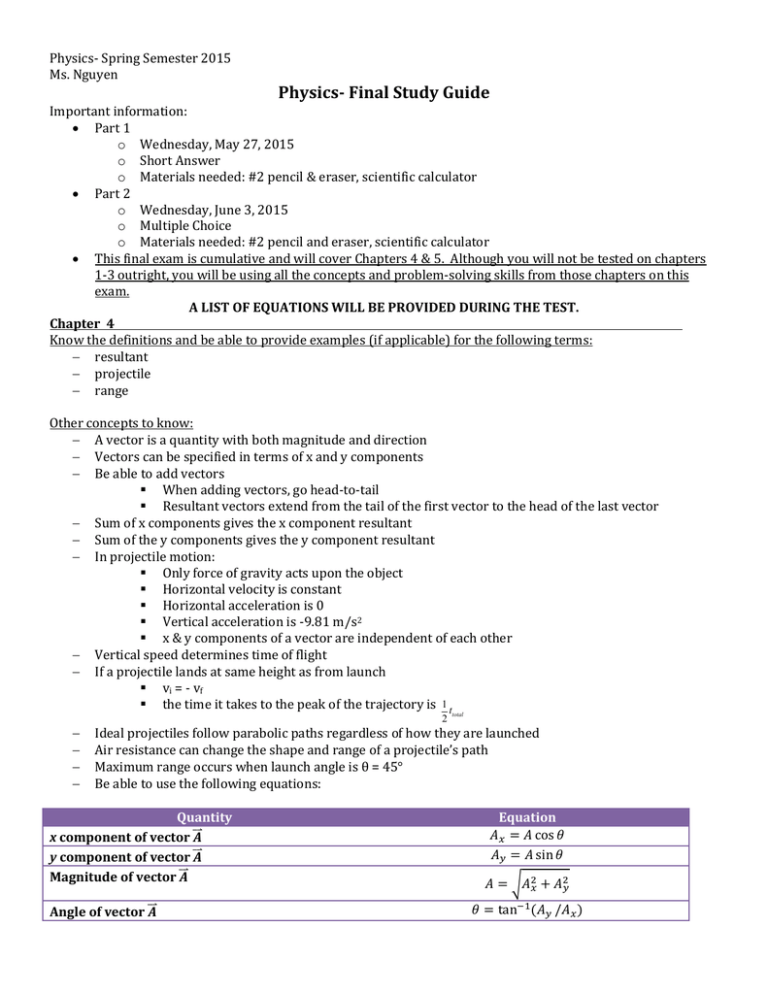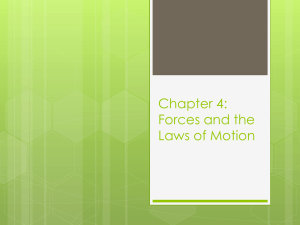Physics- Semester 2 Finals Study Guide
advertisement

Physics- Spring Semester 2015 Ms. Nguyen Physics- Final Study Guide Important information: Part 1 o Wednesday, May 27, 2015 o Short Answer o Materials needed: #2 pencil & eraser, scientific calculator Part 2 o Wednesday, June 3, 2015 o Multiple Choice o Materials needed: #2 pencil and eraser, scientific calculator This final exam is cumulative and will cover Chapters 4 & 5. Although you will not be tested on chapters 1-3 outright, you will be using all the concepts and problem-solving skills from those chapters on this exam. A LIST OF EQUATIONS WILL BE PROVIDED DURING THE TEST. Chapter 4 Know the definitions and be able to provide examples (if applicable) for the following terms: resultant projectile range Other concepts to know: A vector is a quantity with both magnitude and direction Vectors can be specified in terms of x and y components Be able to add vectors When adding vectors, go head-to-tail Resultant vectors extend from the tail of the first vector to the head of the last vector Sum of x components gives the x component resultant Sum of the y components gives the y component resultant In projectile motion: Only force of gravity acts upon the object Horizontal velocity is constant Horizontal acceleration is 0 Vertical acceleration is -9.81 m/s2 x & y components of a vector are independent of each other Vertical speed determines time of flight If a projectile lands at same height as from launch vi = - vf the time it takes to the peak of the trajectory is 1 t 2 total Ideal projectiles follow parabolic paths regardless of how they are launched Air resistance can change the shape and range of a projectile’s path Maximum range occurs when launch angle is θ = 45° Be able to use the following equations: Quantity ⃑ x component of vector 𝑨 ⃑ y component of vector 𝑨 ⃑ Magnitude of vector 𝑨 ⃑ Angle of vector 𝑨 Equation 𝐴𝑥 = 𝐴 cos 𝜃 𝐴𝑦 = 𝐴 sin 𝜃 𝐴 = √𝐴2𝑥 + 𝐴2𝑦 𝜃 = tan−1 (𝐴𝑦 /𝐴𝑥 ) Position- time equations Velocity- time equations Position- time equations for launch at angle Velocity- time equations for launch at angle 𝑥𝑓 = 𝑥𝑖 + 𝑣𝑥,𝑖 𝑡 1 𝑦𝑓 = 𝑦𝑖 + 𝑣𝑦,𝑖 𝑡 − 𝑔𝑡 2 2 𝑣𝑥,𝑓 = 𝑣𝑥,𝑖 𝑣𝑦,𝑓 = 𝑣𝑦,𝑖 − 𝑔𝑡 𝑥𝑓 = 𝑥𝑖 + (𝑣𝑖 cos 𝜃)𝑡 1 𝑦𝑓 = 𝑦𝑖 + (𝑣𝑖 sin 𝜃)𝑡 − 𝑔𝑡 2 2 𝑣𝑥,𝑓 = 𝑣 𝑖 cos 𝜃 𝑣𝑦,𝑓 = 𝑣𝑖 sin 𝜃 − 𝑔𝑡 Chapter 5 Know the definitions and be able to provide examples (if applicable) for the following terms: - force - Hooke’s law - net force - spring constant - inertia - tension - Newton - equilibrium - free-body diagram - friction - normal force Other concepts to know: - Two quantities characterize a force: o the strength, or magnitude of the force o the direction in which the force acts - All 3 of Newton’s laws - Objects don't start or stop moving on their own. - If the net force on an object is zero, its velocity is constant (no acceleration) - Mass is a measure of the amount of matter something contains o Unit of mass= kg - More massive objects have more inertia than less massive objects - Newton’s first law: o An object at rest remains at rest as long as no net force acts on it o An object moving with constant velocity continues to move with the same speed and in the same direction as long as no net force acts on it. - Newton’s second law: o F=ma o Used to calculate the force when the mass and acceleration are known & in situations in which several forces are acting on an object. o Acceleration is directly proportional to NET force o Acceleration is inversely proportional to mass - Newton's third law: o Forces always come in pairs. That is, there are no isolated forces in the universe. o The forces in a pair are equal in magnitude and opposite in direction. o The forces in a pair act on different objects. o “For every action, there is an equal and opposite reaction.” o Examples: Note that in the three examples in the figure, the paired action-reaction forces act on different objects. As a result, the two forces do not cancel. - - - Be able to describe the different kinds of forces, identify an example of each, and write their symbol: o Normal force o Friction o Spring force o Weight o Air resistance o Applied force o Tension Be able to draw a free-body diagram Understand mass vs. weight The larger the spring constant, the greater the force exerted by the spring. A large spring constant corresponds to a stiff spring. Objects with zero acceleration are said to be in equilibrium. o According to Newton's second law, the net force must equal zero if an object is not accelerating. o Thus, an object in equilibrium is subject to zero net force ΣF=0 o An object in equilibrium may be either at rest or moving with a constant velocity. Be able to explain static vs. kinetic friction A stationary object begins to move when the applied force equals the maximum force of static friction. Once an object is moving, kinetic friction comes into play. In general, µs is greater than µk. Be able to use the following equations: ∑ 𝐹 = 𝑚𝑎 𝑊 = 𝑚𝑔 𝑓𝑘 = 𝜇𝑘 𝑁 𝐹 = 𝑘𝑥 𝑓𝑠,𝑚𝑎𝑥 = 𝜇𝑠 𝑁 Chapter 6 Know the definitions and be able to provide examples (if applicable) for the following terms: work joule Other concepts to know: Be able to define the sign/direction of work If work Is done when a force is applied to an object, the object moves in the direction of the applied force Only the component of the force in the direction of the displacement does work Work is positive if the force has a component in the direction of motion Work is zero if the force has NO component in the direction of motion or if distance moved is zero Work is negative if the force has a component OPPOSITE to the direction of motion Be able to use the following equations: W=Fd W=Fdcosθ



